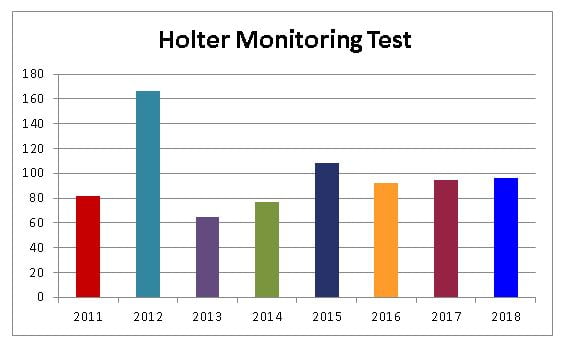Holter Monitoring
What is a Holter monitor?
A Holter monitor is a device used to record a continuous electrocardiogram for 24 to 48 hours. The electrical activity of your heart is recorded on a tape cassette. You wear the monitor and place signals on the tape to mark symptoms or events. Such monitors, also called ambulatory electrocardiographic monitors (AEMs), have been around for 30 years.Holter monitors are mostly used for two purposes:to observe and record heart rhythm and any abnormality that might occur to look for times when the heart muscle is not getting enough blood flow through the coronary arteries.
When is it used?
Symptoms such as dizziness, palpitations, and shortness of breath, fainting spells, and chest pain may have many different causes. A Holter monitor is used to find out if your heart is causing your symptoms. Heartbeats that are either too fast or too slow may cause light-headedness or fainting. However, these symptoms may not last long enough to show up on an electrocardiogram in your health care provider’s office or in an emergency room. When the feeling of rapid or irregular heartbeats (palpitations), starts in the upper heart chambers (atria) they are rarely a threat to life. But if they start in the lower chambers (ventricles), they may sometimes be a serious health concern. Holter monitors can usually pinpoint the origin of palpitations and help your health care provider decide on a treatment.
Coronary arteries can be fully or partially blocked by atherosclerosis, or “hardening of the arteries.” The artery itself responds to signals that tell it to expand (dilate) or narrow (constrict.) Either kind of signal may cause a temporary decrease in blood supply to the heart muscle. The Holter monitor can detect these events, alerting your health care provider to possible problems. It can help identify people at higher risk of heart attack or sudden death.
What happens during the procedure?
In the health care provider’s office, the hospital, or clinic you will be asked to remove your clothes down to the waist. Men will have portions of their chest hair shaved. You will then have sticky electrodes put in position with adhesive. The electrodes are attached to a small tape recorder. The recorder is carried on a belt or shoulder strap. You will be given a diary to record your activities or symptoms for the next 24 or 48 hours. When you return to the office or clinic, the electrodes will be removed. The tape and diary will be reviewed. The procedure is very safe, although sometimes the electrode attachments irritate the skin.
What happens after the procedure?
Your health care provider will review the Holter monitor tape and tell you about the results at your next visit or sooner, if needed. Sometimes, such as when you are taking new medicine, repeated monitoring may be required. Holter monitors are a useful way to detect heart rhythm prob lems that otherwise might remain hidden.
lems that otherwise might remain hidden.

